Guitars ‘n Jazz Services and repairs all the instruments that we sell and rent in our own workshop with skilled technicians at very reasonable rates. All repairs, setups, re-frets, stringing fully guaranteed!!! Technicians are available 3 days each week, so much of the work can be done in less than a week, and in some cases even the same day.
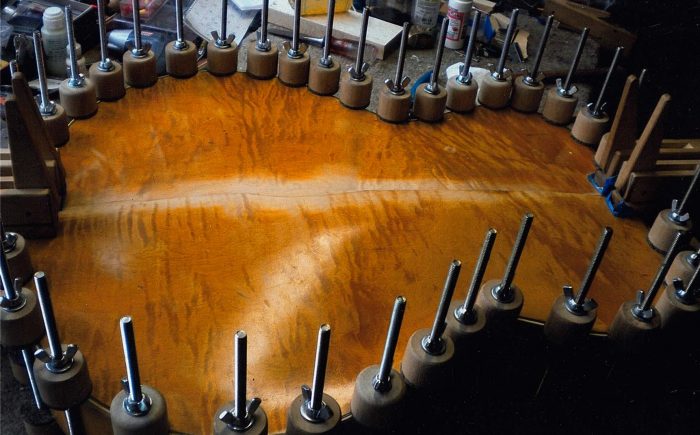
Please click on the tabs below for more information:
The skillfully trained Technicians at Guitars ‘n Jazz are very experienced in repairing all the fret, bridge, nut, tuning, intonation, and other problems listed below.
Fret Problems:
- Strings are rattling on the frets
- Notes are choking when bending strings
- Strings are slipping of the edge of the fingerboard
- Fret edges are sharp and cutting into your fingers
- Performance of fretwork is not accurate for fluid styles
- Certain notes buzz and rattle
Bridge and Nut Problems:
- Strings are breaking at the saddles
- Strings are catching in the nut slots therefore affecting tuning
- Strings not seated correctly in nut or saddle making a rattling sound
- The tremolo (vibrato) is not returning to its neutral position
- Strings are not well spaced to suit the fingerboard taper
- Strings not equally spaced at nut
- Strings not equally spaced at saddle
- Strings require too much pressure to hold down
- Wooden Saddle has collapsed in the centre from wear
- The feet of the wooden bridge do not match the curvature of the soundboard under string tension
Tuning and Intonation:
- Chords don’t play in tune evenly over the entire fingerboard
- Are you experiencing difficulties in tuning your guitar?
- Does it seem impossible to tune even after checking with a tuner
- The tremolo arm is not returning to pitch after use.
- Chords sound out of tune in one position whilst acceptable in others.
- Pre fabricated saddle does not suit your string choice
- Too much resonance between the bridge and tail piece.
Other Problems:
- Strap buttons can no longer be tightened
- Set up of strings is not to your satisfaction
- The current setup of your guitar does not suit your playing style
- Wood has split along the grain in the vicinity of the f holes
- Sympathetic resonance problems that are hard to locate.
Technicians at Guitars ‘n Jazz are very experienced in pickup and electronic problems:
- Volume controls and electrics are scratchy or cutting out
- The output jack is cutting out or is loose
- Switch is cutting out or not selecting the various pickups.
- Pickups make squealing noises at high volume.
- There is no output whatsoever.
- Pickup outputs are not balanced.
- There is excessive humming and noise when instrument is plugged in.
- The signal is not very clear.
- The signal is too thin almost metallic sounding.
Guitars ‘n Jazz can restring and setup your guitars quickly and accurately. From the time you restring your guitar you will notice the following: the strings will be stretching out of tune and the tone of the strings will be very bright. However, as the strings settle the tone will even out and the tuning will stabilize. When excessive dents are left from fretting the strings you will notice the tone is mellower and in some cases excessive string wear will affect the intonation and tuning. This could be an indication to change strings.
Each year you should have your guitar checked and setup by one of our technicians. After years of playing, you may wear grooves into your frets where they meet the strings and this may lead to buzzing or intonation problems. If necessary, frets can be lightly leveled and dressed just as they are when they are first installed on your guitar. Our technicians can level the frets, re-crown them, and finish and round the fret ends and then polish the frets just as they were when you first received your guitar. Not all guitars come from the manufacturer with the precision and playability of a good fret dressing, and most professional players bring their guitars to their technician for a setup and fret dressing before playing a new guitar.
There are two ways of attaching the string, standard and with a knot locking string to post. The standard method is used by many manufacturers. It is easy to remove strings as well as install them, it is easier for the strings to slip out of tune on guitars with tremolos. Locking a string to the post requires an accurate technique which secures the string. This method is used by major manufacturers like Maton, Martin, and Gibson.
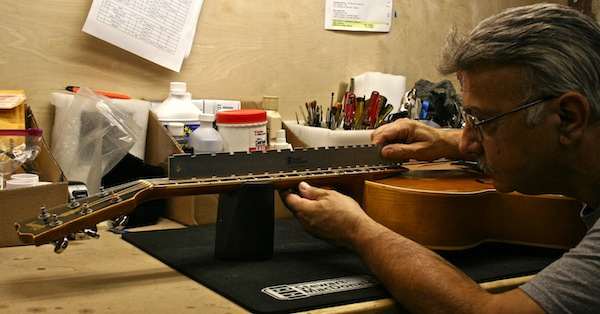
CHECKING AND STRAIGHTENING THE NECK

MEASURING STRING HEIGHT AT 12TH FRET

ADJUSTING THE TRUSS ROD

ADJUSTING THE TRUSS ROD TO GET PROPER NECK RELIEF
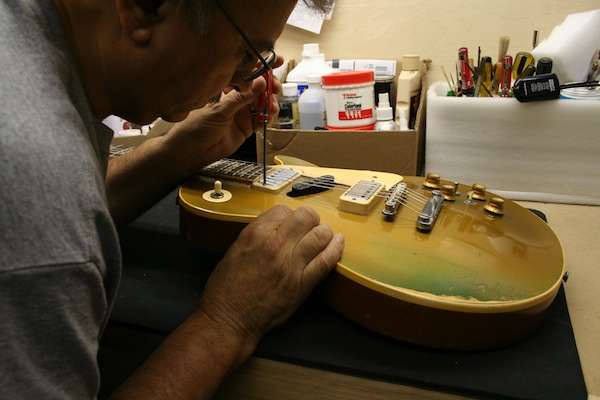
ADJUSTING THE PICKUP HEIGHT FOR BEST TONE
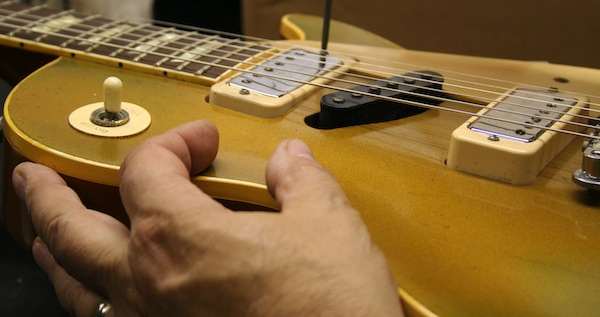
ADJUSTING THE PICKUP POLES TO GET PROPER AMPLIFIED BALANCED TONE
Guitars ‘n Jazz technicians can expertly re-fret your archtop and acoustic guitar when necessary. You will be amazed how well your guitar can play with a new fret dressing and leveling (only if necessary).
We can help you determine the correct fret wire choices – small, medium or jumbo profiles, soft medium or hard density, and nickel silver, stainless steel or brass alloy.
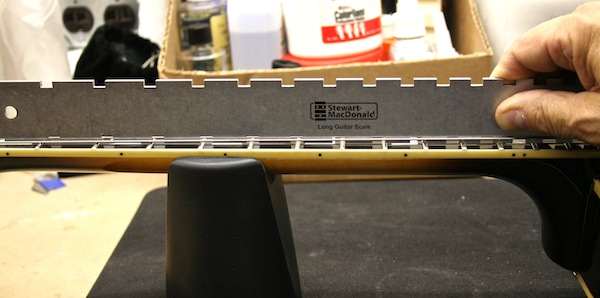
STRAIGHTENING THE NECK

CHECKING FOR HIGH OR LOW FRETS

CHECKING THE ACTION

ADJUSTING THE THUMBWHEELS OF THE BRIDGE
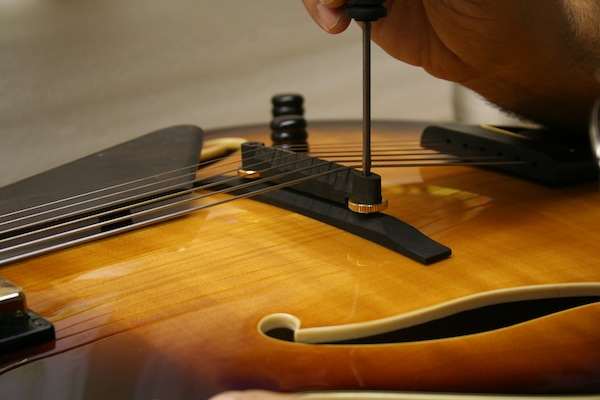
ADJUSTING THE THUMBWHEELS OF THE BRIDGE
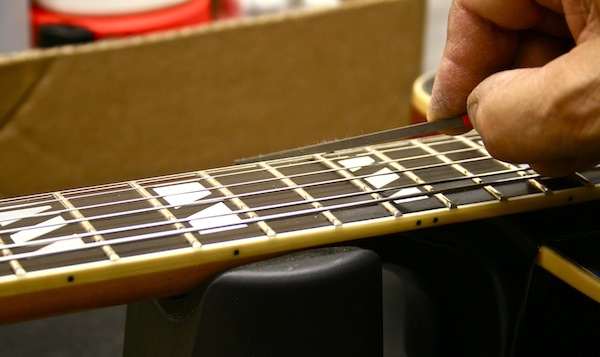
CHECKING FOR SHARP FRET ENDS AND FILING THEM SMOOTH
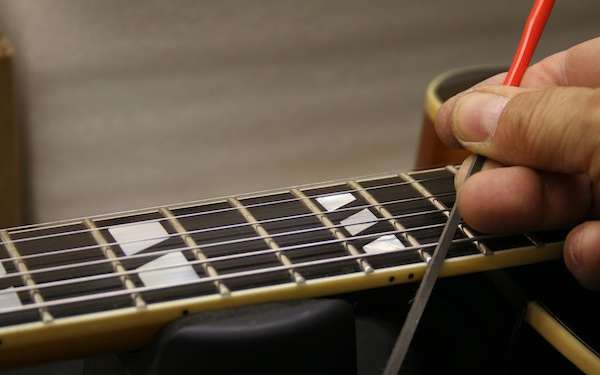
CHECKING FOR SHARP FRET ENDS AND FILING THEM SMOOTH

Soldering

Soldering
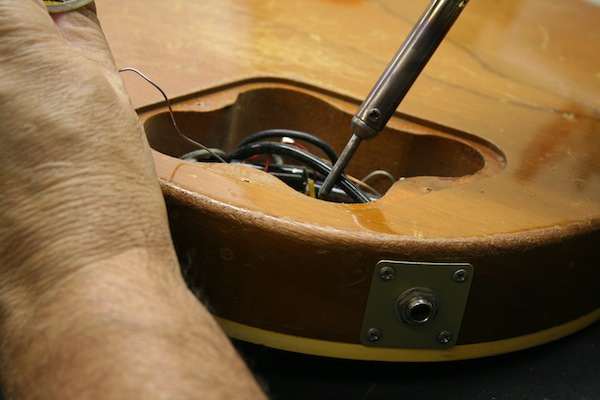
Soldering
Hand Carved Archtops are Solid wood guitars are made carved solid wood that are directly affected by humidity and temperature.
Humidity is the amount of water vapor or moisture in the air. Temperature affects the amount of moisture that air can hold. Both of these factors affect wood because it is naturally “hygroscopic”. This means that it takes on and gives off water. A guitar that absorbs too much moisture, through high humidity, expands and swells. This distorts the geometry of the guitar and, consequently, its tone and playability. Add high temperature, and humidity can weaken glue joints and even cause them to fail. With prolonged exposure, the glue under the bridge will weaken, allowing the bridge to pull off.
Telltale signs of a wet guitar:
- High action
- Swollen top
- Fret buzzing in the high registers (as fretboard rises with the top)
- Distorted back and sides
- Finish cracks Bindings separated
Overly dry conditions, or lack of sufficient humidity, can be equally detrimental to your guitar, causing the wood to shrink and crack. It can also cause poor tone and improper intonation. In dry regions (mountainous or desert areas) or northern climates, where heated air is common in winter, simple guitar humidifiers may not be sufficient. Room or household humidifiers may be necessary to maintain a proper environment. If you run the meaty part of your finger across the grain and you can feel the grain.
This is a major signs of a “dry” guitar:
- Lowered action
- Fret buzzing and lifting
- Fret ends sticking out from the fingerboard
- Dips in the top or back
- Finish and/or wood cracks
Gradual changes in humidity and temperature will generally not harm a well-made guitar. Guitars n Jazz maintains 49% relative humidity and a temperature of 75 degrees. So if you keep guitar pretty close to these ranges, you should have no problems.
The biggest danger caused by humidity and temperature is rapid or extreme changes. That’s because different parts of the guitar shrink and expand at different rates. For example, if your local humidity drops very rapidly, the guitar cannot acclimate itself uniformly, causing cracks or failure of glue joints in different portions of the guitar as it tries to “cope” with the drying situation. The same is true, in reverse, with high humidity. Extreme temperatures can wreak havoc, too. Heat weakens glue. Cold “chills” lacquer causing finishes to crack or craze.
While you can’t control the weather, you can control your guitar’s environment to a great extent. Here are some simple pointers.
- Keep your guitar in its case when you’re not playing it because it’s a lot easier to control humidity in a smaller volume of air.
- Purchase a home hygrometer/thermometer to keep tabs on the relative humidity and temperature. Adjust your home environment as necessary. Plants and humidifiers add moisture in dry winter months. Air conditioning controls humidity in the hot, muggy summer months.
- Avoid storing your guitar near sources of hot, dry air (such as forced hot air heating ducts), or cold, damp areas (garages, basements, closets with outside walls).
- Never, ever, transport your guitar in a car trunk. Temperatures inside car trunks are extreme in any kind of weather. It’s the quickest way to destroy a guitar. Even in the passenger compartment your guitar can be subjected to extreme temperatures. For example, please allow your instrument to warm up slowly before opening your case in a warm room after being transported in a cold vehicle. That’s a sure way to get finish crazing.
- When traveling cross country, keep in mind changes in local humidity – and protect your guitar accordingly.
- Guitar humidifiers that fit inside the sound hole or extend into the body can be very effective but must be used with great care to avoid water damage. Check with a qualified guitar repair person before using them.
Fine Guitars are finished with multiple coats of high-grade lacquer, hand-sanded between applications to bring out a deep shine. The resultant finish is thin, durable and acoustically compatible. The best way to preserve this finish is to keep it clean – wiping off perspiration and fingerprints with a soft, damp (not wet) cloth. Old, soft cotton baby diapers make excellent guitar cleaning cloths. While there are many commercial guitar cleaners available, we feel that a rag slightly dampened with plain tap water and thoroughly wrung out will remove most dirt. Then buff with dry clean cloth. If you must use commercial products, avoid those with solvents, silicones or abrasives- Meguire’s Mirror Glaze #7 is a non abrasive wax that is used on the delicate clear coats of cars and works very well on guitars. Less is always best.
Click here for a great link to show many of the problems and solutions